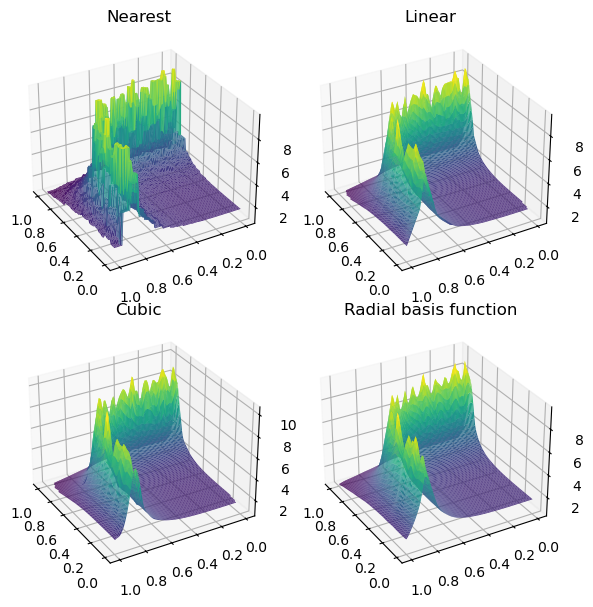This notebook uses examples from scipy documentation to demonstrate HARK’s UnstructuredInterp class.
from __future__ import annotations
import matplotlib.pyplot as plt
import numpy as np
from multinterp.unstructured import UnstructuredInterpSuppose we have a collection of values for an unknown function along with their respective coordinate points. For illustration, assume the values come from the following function:
def function_1(x, y):
return x * (1 - x) * np.cos(4 * np.pi * x) * np.sin(4 * np.pi * y**2) ** 2The points are randomly scattered in the unit square and therefore have no regular structure.
rng = np.random.default_rng(0)
rand_x, rand_y = rng.random((2, 1000))
values = function_1(rand_x, rand_y)Now suppose we would like to interpolate this function on a rectilinear grid, which is known as “regridding”.
grid_x, grid_y = np.meshgrid(
np.linspace(0, 1, 100), np.linspace(0, 1, 100), indexing="ij"
)To do this, we use HARK’s UnstructuredInterp class. The class takes the following arguments:
values: an ND-array of values for the function at the pointsgrids: a list of ND-arrays of coordinates for the pointsmethod: the interpolation method to use, with options “nearest”, “linear”, “cubic” (for 2D only), and “rbf”. The default is'linear'.
nearest_interp = UnstructuredInterp(values, (rand_x, rand_y), method="nearest")
linear_interp = UnstructuredInterp(values, (rand_x, rand_y), method="linear")
cubic_interp = UnstructuredInterp(values, (rand_x, rand_y), method="cubic")
rbf_interp = UnstructuredInterp(values, (rand_x, rand_y), method="rbf")Once we create the interpolator objects, we can use them using the __call__ method which takes as many arguments as there are dimensions.
nearest_grid = nearest_interp(grid_x, grid_y)
linear_grid = linear_interp(grid_x, grid_y)
cubic_grid = cubic_interp(grid_x, grid_y)
rbf_grid = rbf_interp(grid_x, grid_y)Now we can compare the results of the interpolation with the original function. Below we plot the original function and the sample points that are known.
plt.imshow(function_1(grid_x, grid_y).T, extent=(0, 1, 0, 1), origin="lower")
plt.plot(rand_x, rand_y, "ok", ms=2, label="input points")
plt.title("Original")
plt.legend(loc="lower right")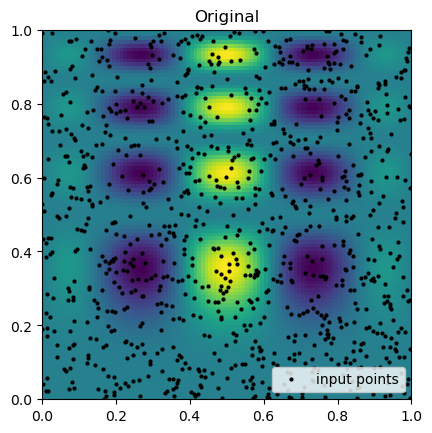
Then, we can look at the result for each method of interpolation and compare it to the original function.
fig, axs = plt.subplots(2, 2, figsize=(6, 6))
titles = ["Nearest", "Linear", "Cubic", "Radial basis function"]
grids = [nearest_grid, linear_grid, cubic_grid, rbf_grid]
for ax, title, grid in zip(axs.flat, titles, grids):
im = ax.imshow(grid.T, extent=(0, 1, 0, 1), origin="lower")
ax.set_title(title)
plt.tight_layout()
plt.show()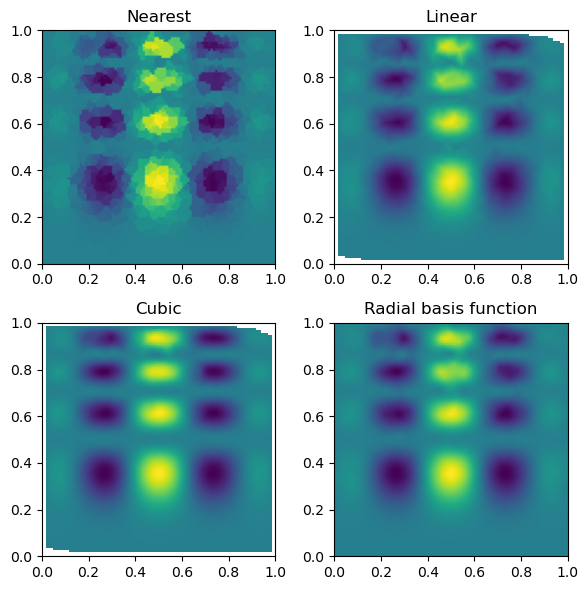
Another Example¶
def function_2(x, y):
return np.hypot(x, y)rng = np.random.default_rng(0)
rand_x = rng.random(20) - 0.5
rand_y = rng.random(20) - 0.5
values = function_2(rand_x, rand_y)
grid_x = np.linspace(min(rand_x), max(rand_x))
grid_y = np.linspace(min(rand_y), max(rand_y))
grid_x, grid_y = np.meshgrid(grid_x, grid_y)nearest_interp = UnstructuredInterp(values, (rand_x, rand_y), method="nearest")
linear_interp = UnstructuredInterp(values, (rand_x, rand_y), method="linear")
cubic_interp = UnstructuredInterp(values, (rand_x, rand_y), method="cubic")
rbf_interp = UnstructuredInterp(values, (rand_x, rand_y), method="rbf")nearest_grid = nearest_interp(grid_x, grid_y)
linear_grid = linear_interp(grid_x, grid_y)
cubic_grid = cubic_interp(grid_x, grid_y)
rbf_grid = rbf_interp(grid_x, grid_y)plt.imshow(function_2(grid_x, grid_y).T, extent=(-0.5, 0.5, -0.5, 0.5), origin="lower")
plt.plot(rand_x, rand_y, "ok", label="input points")
plt.title("Original")
plt.legend(loc="lower right")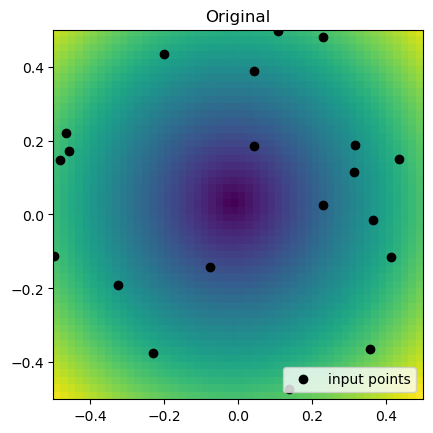
fig, axs = plt.subplots(2, 2, figsize=(7, 6))
titles = ["Nearest", "Linear", "Cubic", "Radial basis function"]
grids = [nearest_grid, linear_grid, cubic_grid, rbf_grid]
for _i, (ax, title, grid) in enumerate(zip(axs.flat, titles, grids)):
im = ax.pcolormesh(grid_x, grid_y, grid, shading="auto")
pts = ax.plot(rand_x, rand_y, "ok", label="input points")
ax.set_title(title)
fig.legend(handles=pts, loc="lower center")
cbar = fig.colorbar(im, ax=axs)
for ax in axs.flat:
ax.axis("equal")
plt.show()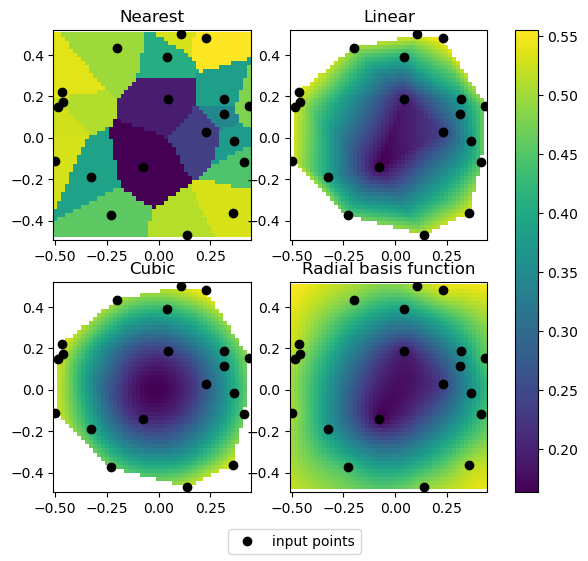
Unstructured Interpolators with Curvilinear Grids¶
def function_3(u, v):
return u * np.cos(u * v) + v * np.sin(u * v)rng = np.random.default_rng(0)
warp_factor = 0.1
x_list = np.linspace(0, 3, 10)
y_list = np.linspace(0, 3, 10)
x_temp, y_temp = np.meshgrid(x_list, y_list, indexing="ij")
rand_x = x_temp + warp_factor * (rng.random((x_list.size, y_list.size)) - 0.5)
rand_y = y_temp + warp_factor * (rng.random((x_list.size, y_list.size)) - 0.5)
values = function_3(rand_x, rand_y)grid_x, grid_y = np.meshgrid(
np.linspace(0, 3, 100), np.linspace(0, 3, 100), indexing="ij"
)methods = ["nearest", "linear", "cubic", "rbf"]
nearest_interp, linear_interp, cubic_interp, rbf_interp = (
UnstructuredInterp(values, (rand_x, rand_y), method=method) for method in methods
)interp_funcs = [nearest_interp, linear_interp, cubic_interp, rbf_interp]
nearest_grid, linear_grid, cubic_grid, rbf_grid = (
interp_func(grid_x, grid_y) for interp_func in interp_funcs
)plt.imshow(function_3(grid_x, grid_y).T, extent=(0, 3, 0, 3), origin="lower")
plt.plot(rand_x.flat, rand_y.flat, "ok", ms=2, label="input points")
plt.title("Original")
plt.legend(loc="lower right")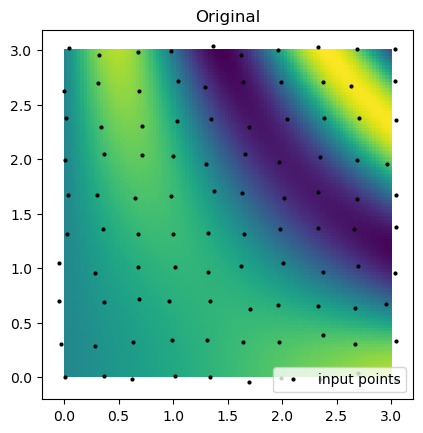
fig, axs = plt.subplots(2, 2, figsize=(6, 6))
titles = ["Nearest", "Linear", "Cubic", "Radial basis function"]
grids = [nearest_grid, linear_grid, cubic_grid, rbf_grid]
for ax, title, grid in zip(axs.flat, titles, grids):
im = ax.imshow(grid.T, extent=(0, 3, 0, 3), origin="lower")
ax.set_title(title)
plt.tight_layout()
plt.show()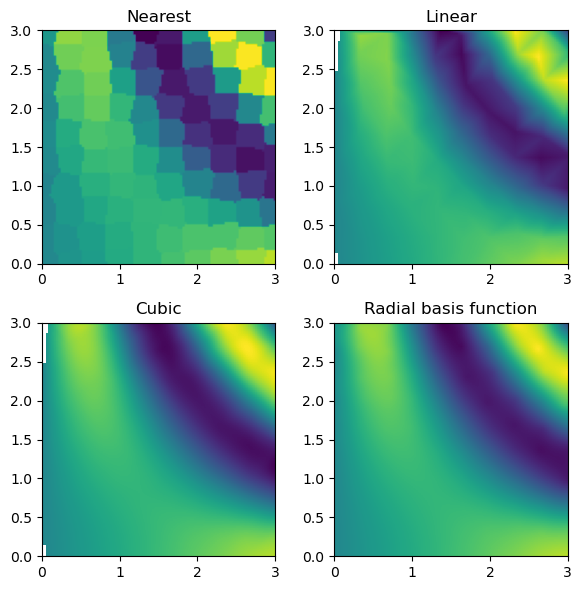
def function_4(x, y):
return 3.0 * x**2.0 + x * y + 4.0 * y**2.0rng = np.random.default_rng(0)
warp_factor = 0.2
x_list = np.linspace(0, 5, 20)
y_list = np.linspace(0, 5, 20)
x_temp, y_temp = np.meshgrid(x_list, y_list, indexing="ij")
rand_x = x_temp + warp_factor * (rng.random((x_list.size, y_list.size)) - 0.5)
rand_y = y_temp + warp_factor * (rng.random((x_list.size, y_list.size)) - 0.5)
values = function_4(rand_x, rand_y)grid_x, grid_y = np.meshgrid(
np.linspace(0, 5, 100), np.linspace(0, 5, 100), indexing="ij"
)methods = ["nearest", "linear", "cubic", "rbf"]
nearest_interp, linear_interp, cubic_interp, rbf_interp = (
UnstructuredInterp(values, (rand_x, rand_y), method=method) for method in methods
)interp_funcs = [nearest_interp, linear_interp, cubic_interp, rbf_interp]
nearest_grid, linear_grid, cubic_grid, rbf_grid = (
interp_func(grid_x, grid_y) for interp_func in interp_funcs
)plt.imshow(function_4(grid_x, grid_y).T, extent=(0, 5, 0, 5), origin="lower")
plt.plot(rand_x.flat, rand_y.flat, "ok", ms=2, label="input points")
plt.title("Original")
plt.legend(loc="lower right")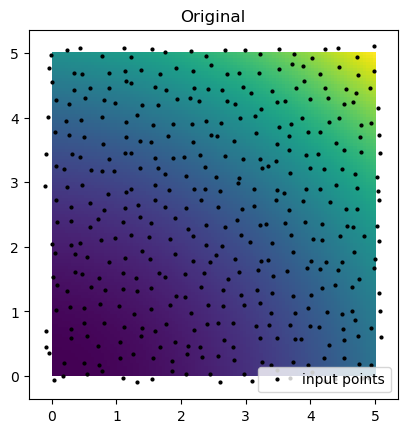
fig, axs = plt.subplots(2, 2, figsize=(6, 6))
titles = ["Nearest", "Linear", "Cubic", "Radial basis function"]
grids = [nearest_grid, linear_grid, cubic_grid, rbf_grid]
for ax, title, grid in zip(axs.flat, titles, grids):
im = ax.imshow(grid.T, extent=(0, 5, 0, 5), origin="lower")
ax.set_title(title)
plt.tight_layout()
plt.show()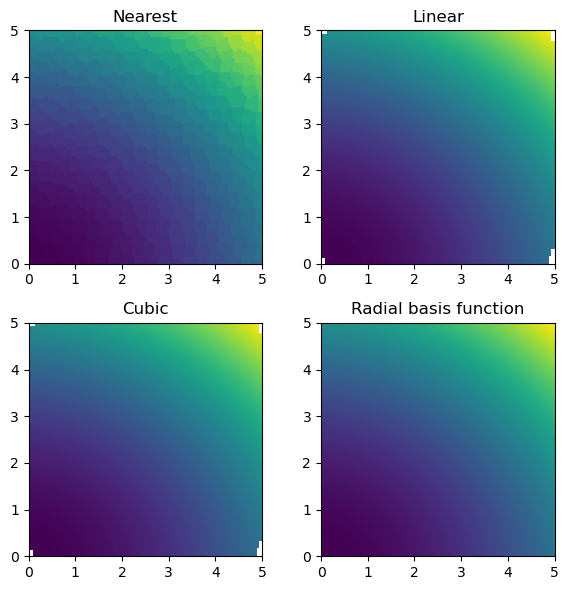
More complex functions¶
def function_5(*args):
return np.maximum(
0.0,
1.0
- np.exp(0.5 - np.prod(np.asarray(args) + 0.2, axis=0) ** (1.0 / len(args))),
)rng = np.random.default_rng(0)
rand_x, rand_y = rng.random((2, 1000))
values = function_5(rand_x, rand_y)grid_x, grid_y = np.meshgrid(
np.linspace(0, 1, 100), np.linspace(0, 1, 100), indexing="ij"
)nearest_interp = UnstructuredInterp(values, (rand_x, rand_y), method="nearest")
linear_interp = UnstructuredInterp(values, (rand_x, rand_y), method="linear")
cubic_interp = UnstructuredInterp(values, (rand_x, rand_y), method="cubic")
rbf_interp = UnstructuredInterp(values, (rand_x, rand_y), method="rbf")nearest_grid = nearest_interp(grid_x, grid_y)
linear_grid = linear_interp(grid_x, grid_y)
cubic_grid = cubic_interp(grid_x, grid_y)
rbf_grid = rbf_interp(grid_x, grid_y)ax = plt.axes(projection="3d")
ax.plot_surface(
grid_x,
grid_y,
function_5(grid_x, grid_y),
rstride=1,
cstride=1,
cmap="viridis",
edgecolor="none",
)
ax.scatter(rand_x, rand_y, values, c=values, cmap="viridis", label="input points")
plt.title("Original")
plt.legend(loc="lower right")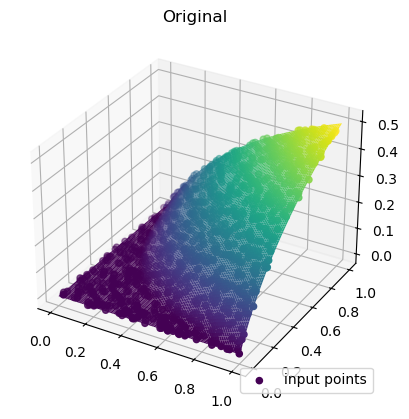
fig, axs = plt.subplots(2, 2, figsize=(6, 6), subplot_kw={"projection": "3d"})
titles = ["Nearest", "Linear", "Cubic", "Radial basis function"]
grids = [nearest_grid, linear_grid, cubic_grid, rbf_grid]
for ax, title, grid in zip(axs.flat, titles, grids):
im = ax.plot_surface(
grid_x, grid_y, grid, rstride=1, cstride=1, cmap="viridis", edgecolor="none"
)
ax.set_title(title)
plt.tight_layout()
plt.show()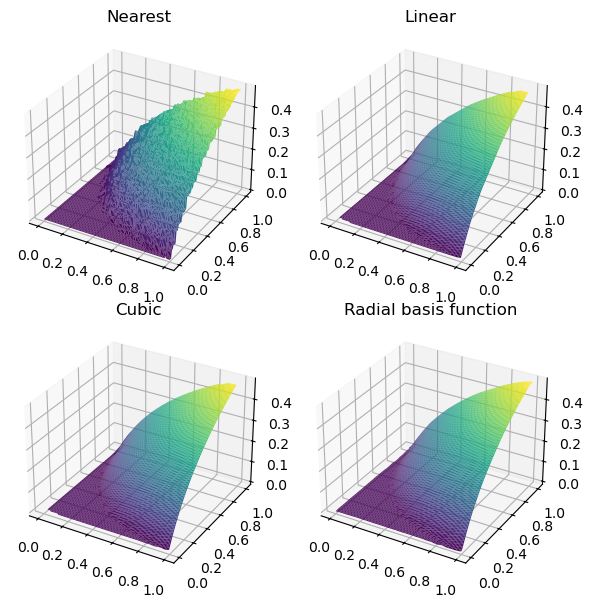
def function_6(x, y):
return 1 / (np.abs(0.5 - x**4 - y**4) + 0.1)rng = np.random.default_rng(0)
rand_x, rand_y = rng.random((2, 1000))
values = function_6(rand_x, rand_y)grid_x, grid_y = np.meshgrid(
np.linspace(0, 1, 100), np.linspace(0, 1, 100), indexing="ij"
)nearest_interp = UnstructuredInterp(values, (rand_x, rand_y), method="nearest")
linear_interp = UnstructuredInterp(values, (rand_x, rand_y), method="linear")
cubic_interp = UnstructuredInterp(values, (rand_x, rand_y), method="cubic")
rbf_interp = UnstructuredInterp(values, (rand_x, rand_y), method="rbf")nearest_grid = nearest_interp(grid_x, grid_y)
linear_grid = linear_interp(grid_x, grid_y)
cubic_grid = cubic_interp(grid_x, grid_y)
rbf_grid = rbf_interp(grid_x, grid_y)ax = plt.axes(projection="3d")
ax.plot_surface(
grid_x,
grid_y,
function_6(grid_x, grid_y),
rstride=1,
cstride=1,
cmap="viridis",
edgecolor="none",
)
ax.scatter(rand_x, rand_y, values, c=values, cmap="viridis", label="input points")
ax.view_init(30, 150)
plt.title("Original")
plt.legend(loc="lower right")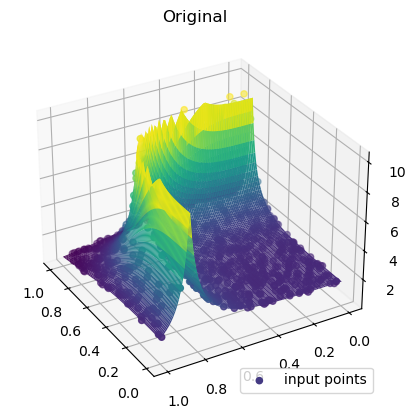
fig, axs = plt.subplots(2, 2, figsize=(6, 6), subplot_kw={"projection": "3d"})
titles = ["Nearest", "Linear", "Cubic", "Radial basis function"]
grids = [nearest_grid, linear_grid, cubic_grid, rbf_grid]
for ax, title, grid in zip(axs.flat, titles, grids):
im = ax.plot_surface(
grid_x, grid_y, grid, rstride=1, cstride=1, cmap="viridis", edgecolor="none"
)
ax.set_title(title)
ax.view_init(30, 150)
plt.tight_layout()
plt.show()